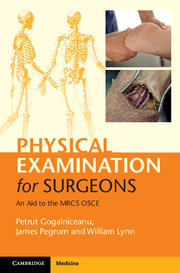Book contents
- Frontmatter
- Dedication
- Contents
- List of contributors
- Introduction
- Acknowledgments
- List of abbreviations
- Section 1 Principles of surgery
- Section 2 General surgery
- Section 3 Breast surgery
- Section 4 Pelvis and perineum
- Section 5 Orthopaedic surgery
- 14 Generic joint examination
- 15 Examination of gait
- 16 Examination of the cervical and thoracic spine
- 17 Cervical spine injury: assessment in trauma
- 18 Examination of the shoulder
- 19 Examination of the elbow
- 20 Examination of the lumbar spine and sacroiliac joint
- 21 Examination of the hip
- 22 Examination of the knee
- 23 Examination of the ankle
- Section 6 Vascular surgery
- Section 7 Heart and thorax
- Section 8 Head and neck surgery
- Section 9 Neurosurgery
- Section 10 Plastic surgery
- Section 11 Surgical radiology
- Section 12 Airway, trauma and critical care
- Index
21 - Examination of the hip
from Section 5 - Orthopaedic surgery
Published online by Cambridge University Press: 05 July 2015
- Frontmatter
- Dedication
- Contents
- List of contributors
- Introduction
- Acknowledgments
- List of abbreviations
- Section 1 Principles of surgery
- Section 2 General surgery
- Section 3 Breast surgery
- Section 4 Pelvis and perineum
- Section 5 Orthopaedic surgery
- 14 Generic joint examination
- 15 Examination of gait
- 16 Examination of the cervical and thoracic spine
- 17 Cervical spine injury: assessment in trauma
- 18 Examination of the shoulder
- 19 Examination of the elbow
- 20 Examination of the lumbar spine and sacroiliac joint
- 21 Examination of the hip
- 22 Examination of the knee
- 23 Examination of the ankle
- Section 6 Vascular surgery
- Section 7 Heart and thorax
- Section 8 Head and neck surgery
- Section 9 Neurosurgery
- Section 10 Plastic surgery
- Section 11 Surgical radiology
- Section 12 Airway, trauma and critical care
- Index
Summary
Checklist
WIPER
• Patient standing in shorts or underwear, back and knees exposed.
• Access is required to the groin, thighs and gluteal region.
Physiological parameters
Gait
• Asymmetry of spine
• Gait: antalgic, short leg, Trendelenburg gait
• Walking aids
Test
• Trendelenburg's test
Tape: leg length
• Apparent leg length (xiphisternum to medial malleolus)
• True leg length (ASIS to medial malleolus)
Look
• Skin:
• scars, erythema, ecchymosis
• sinuses and alignment of skin creases
• psoas abscess draining in sub gluteal fold
• Soft tissues: swelling or wasting of glutei and quadriceps.
• Bone:
• deformity or asymmetry: shortening of leg; external or internal rotation of hip
• pelvic tilt
• valgus or varus knee, lordosis, kyphosis, scoliosis
Feel
• Skin: temperature, tenderness, sensation.
• Soft tissues:
• adductor tenderness, bursitis
• pulses, capillary refill time
• sensation and movement
• Bone:
• greater trochanter
• midpoint of inguinal ligament (hip joint)
• pubic bone and symphysis
• femoral shaft
• tenderness or mobility
Move
• Active and passive:
• flexion/fixed flexion
• internal rotation (foot moves outwards)
• external rotation (foot moves inwards)
• extension (press thigh onto bed)
• abduction/adduction whilst stabilising pelvis (palpating contralateral ASIS)
• Resisted:
• flexion
• adduction
Special tests (* = essential tests)
• Thomas's test*
• Impingement sign*
• Straight leg raise*
• FABER test
• Sciatic nerve stretch test
• Ober's test
To complete the examination…
• Examine the joint above (back and sacroiliac joint) and the joint below (knee).
• Check full neurovascular status of the lower limb.
• Order appropriate radiographs and further imaging.
Examination notes
What do you look for during gait and initial observations?
• Look for an antalgic gait or the use of any walking aids.
• Inspect the soles of the shoes for the pattern of wear.
• In the setting of possible neck of femur fracture, gait and weight-bearing activities should not be examined.
- Type
- Chapter
- Information
- Physical Examination for SurgeonsAn Aid to the MRCS OSCE, pp. 162 - 174Publisher: Cambridge University PressPrint publication year: 2015



